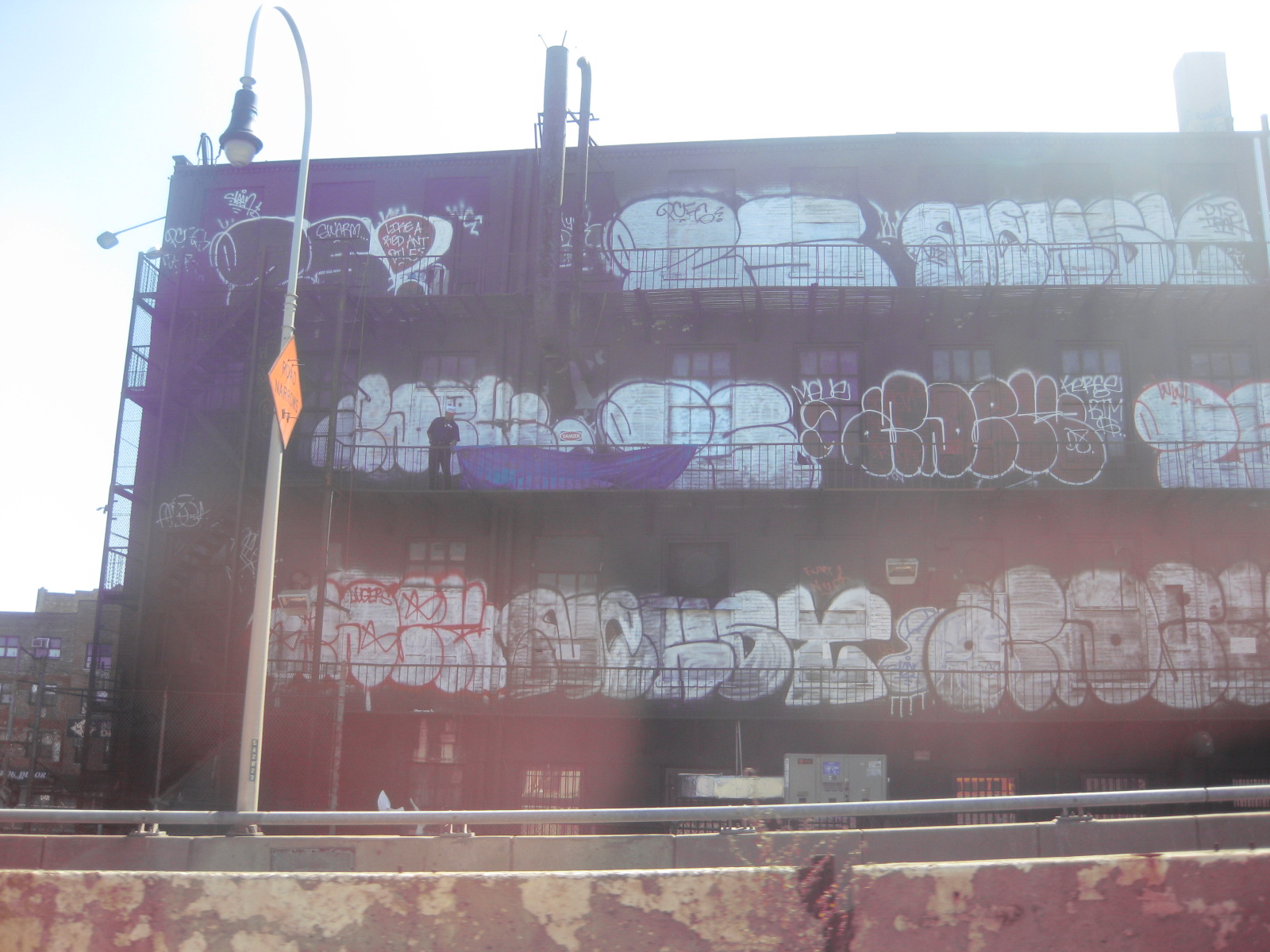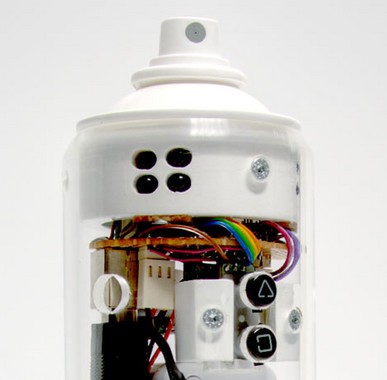NY throwups
foto di F. Fiorentini – clicca per ingrandire

Chronicler of the Furtive Arts
THE young man
had been painting all night, in the dark, wedged between two subway
trains at the New Lots Avenue railyard in Brooklyn. One hand held an
aerosol can; the other was braced against a metal door.
The City
Ms. Cooper’s most recent book is "Going Postal" shows how artists have
applied their logos, "tags" and images on postal stickers affixed to
mailboxes and parking meters. It is "a sign of how graffiti has
progressed and endured," Ms. Cooper says. More Photos »
First
came the outline of the nickname his mother had given him, “D-O-N-D-I,”
and then the shadings and shadow lettering that gave his “piece” its
three-dimensional look. Taxicab yellow, delta blue, orange, pink — the
air was toxic with Krylon. It was sunrise when the painter — and Martha Cooper, the photographer recording his pulsing, illicit art — finished work.
In
the 1970s, Donald White, or “Dondi,” a graffiti writer from East New
York, helped spawn an urban art movement that flourished across five
continents. Ms. Cooper, working for The New York Post, was on its front
lines, documenting the artists who labored in the city’s shadows.
The 1984 book “Subway Art,” Ms. Cooper’s collaboration with Henry Chalfant,
a photographer and filmmaker, captured graffiti’s golden and assaultive
years. It sold half a million copies, becoming the movement’s bible —
and epitaph. But the best of the trains live on, in an updated,
large-format 25th-anniversary edition, to be published next month by
Chronicle Books.
Kodakgirl, as Ms.
Cooper is known to the city’s B-boys and B-girls, has left her own
indelible mark on New York as an obsessive observer of vernacular art
and architecture. She has been taking photographs since age 5, when her
father, the owner of a Baltimore camera shop, gave her a Brownie
camera. She is currently director of photography at City Lore, a center
for urban culture.
She has also
contributed to more than a dozen books, capturing the indomitable
spirit of city youth. Her most recent book, “Going Postal,” published
in December, follows street artists into their new public terrain:
freely accessible postal express stickers, used as a backdrop for their
painting and “delivered” on newspaper boxes and parking meters. She
calls them “a gift to the city.”
An
Upper West Side resident since 1975, Ms. Cooper, 66, lives with her cat
and the clutter of collections: milagros, postal stickers, thousands of
early snapshots of women with cameras and limited-edition Adidas
“Superstar Expression” sneakers commemorating Lee Quiñones, an
influential artist of the subway graffiti movement. They are a gift
from the artist, dedicated “to that special K-girl.” BARBARA GRAUSTARK
•
There was a poem on one of my favorite subway trains. Lee Quiñones painted it.
There was once a time
When the Lexington was a beautiful line
When children of the ghetto expressed with art, not with crime.
But then as evolution passed,
The Transit’s buffing did its blast.
Now the trains look like rusted trash.
Now we wonder if graffiti will ever last.
Well, it did not last
on the city’s trains, except in photographs. And that is one reason I
photograph what I do. I’m not about “art,” or perfect lighting. I’m
more like, “Let’s preserve this.”
My father had a camera store,
and his idea was to go out and look for a picture. He would take me on
what he called camera runs with the Baltimore camera club. You walk
down the street and you see something and you’re excited by it. And you
take a picture.
In Haiti, I had seen kids making toy cars out of
tin cans. And I thought, wow! They made the string from the stems of
plants, the tires, everything. So I began looking for creative forms of
play here.
I really wasn’t looking at graffiti. I collected the planes and a go-kart made from police barricades and had an exhibit at the Museum of the City of New York.
While
doing that project, this boy showed me his book with designs for his
name — He3 — to put on a wall. And he said, Why don’t you take pictures
of graffiti?
I didn’t get it. It was mysterious and illegible
to me. So that was the “Aha” moment — when I recognized that He3 was
really a graphic designer, designing his personal logo. There had been
writing on public walls in Philadelphia in the ’60s, but these kids
were pushing style to such great lengths. It was all about the way the
letters hook up and overlap.
I still can’t read graffiti, though.
Edwin
Serrano, who was He3 — unfortunately, he’s been in and out of prison
for 16 years — said, I can introduce you to a king. The king was Dondi,
who became my mentor.
So we go in my car to East New York, a
wasteland, and knocked on Dondi’s door. He said, “You’re Martha
Cooper?” He had a New York Post picture I had taken of a little girl on
a swing. And behind the swing, in the background, was one of what he
called his throw-ups — his graffiti.
I spent time in his room
while the guys designed their pieces. Nothing was accidental, because
the trains were parked so close together, you couldn’t stand back and
see what it looked like. They had to memorize the colors. Then they
would photograph their own trains.
As soon as I showed them I could bring them back better pictures,
we would get calls, “Yo, Martha, we did a train on this line.” And the
next morning, Henry Chalfant and I would run and try to catch it,
because they didn’t last long.
They knew every color, what was “wak” — out of whack, not right —
and what was a burner — a winner. They had a whole system of
aesthetics. I came to realize what it took to get the right colors, to
plan the piece, to steal the paint, to get into the yard. For anybody
who thinks it’s only vandalism, it’s so way more than that.
Nobody wanted to touch this
vandalism stuff. Remember what the insides of the trains were like?
Unbelievable, 1977, the Bronx was burning down. No one really wanted to
write that graffiti was an interesting thing. Once it moved into the
galleries, it lost something for me. The artists deserve to make money,
but I don’t want to shoot something that’s done with permission. It’s
an outlaw art. That’s what makes it thrilling.
I’m a bit jaded
now about the big walls. I’m not crazy about having street art in my
face. I like to discover things. So when you find a little postal
sticker on a mailbox, it’s just more exciting for me. “Going Postal” is
about modern logos on postal stickers, a sign of how graffiti has
progressed and endured.
I left Baltimore at 16 for college, the Peace Corps,
a job at Yale in the anthropology museum — I never came back. But in
2006 I bought a row house there, in the neighborhood of “The Wire,” a
tough neighborhood a few blocks from where my great-grandparents
settled from Eastern Europe. It’s nice to have that connection again.
For a new project, I’m trying to capture a sense of community there,
how people have survived poverty. I just walk, I take pictures, I go
back and knock on people’s doors and give them the pictures.
There
are three crab houses, and on a warm day in March, a family had set up
a table and were having a feast on the streets. People have backyards,
but the sidewalks are rich with community activities, rich with photo
opportunities. I’m going back to give them these pictures, say, Hi,
remember me? And they’ll be very happy.
Subway Art interview video:
graffiti di THX al CSA Next merson di Firenze realizzato in occasione del concerto di D.O.A. (Canada) 30th Anniversary Tour
clicca sule anteprime per vedere le immagini in dimensioni reali
ripittato i muri dell’emerson e iniziato il graffito dedicato a D.O.A. che sono in concerto per il 30th anniversary tour della band
Domani ci saranno altri writers che pitteranno insieme a me
Presto un po’ difoto del re-styling
(^o^)/




"Il
concetto è molto semplice, trasformare il comando remoto della console
attualmente più famosa al mondo, la Wii appunto, in una sorta di
bomboletta spray virtuale. E proprio uno studente tedesco, Martin Lihs,
dell’Università di Bauhaus in Weimar, ha realizzato per la sua tesi
finale questo originale progetto."
——————–
"Fallo a casa tua"
info — http://accademiafirenze.blogspot.com/2008/07/confessioni-di-un-non-artista-9-luglio.html
writing foto album, testi e scans:
il muro di Berlino – 1mag07-jam – E+_walls – WC hall of fame – Mode 2 – WC Rifredi graffiti – treni Pisa 2007 – oldies – graffiti CPA – treni Firenze 2000 – Next Park jam – burners – Cartoni Animali – graffiti Firenze – Parigi 2009 – WC video – Game Over zine – Frigidaire Hip Hop articles scans – DSS_zine_1-98.rar – writers.txt – graffiti_an_obtrusive_art.txt – Aerosol Art with Writers and Crews.pdf – 400ml.rar
immagine tratta da "Search and destroy" (punk-zine anni ’70 edita da Vale, San Francisco)
Album Parigi 2009 – clicca qui per visualizzare le anteprime delle foto contenute nell’album
tutte le foto: THX 1138 (marzo 2009)
Grind The Street 2
7 marzo 2009
ore 16 — graffiti live performance WILDBOYS da Napoli
ore 18 — freestyle jam con CLEMENTINO, PAURA, DJ JUVERRE & guests — FREEBREAKDANCE con BOLOGNINA BREAKERS
ore 23 — live show:
MANO ARMATA
EMPATIA VENEFICA
CLEMENTINO + PAURA + TAYONE

Strike – via U. Partini 21 Casalbertone, Roma